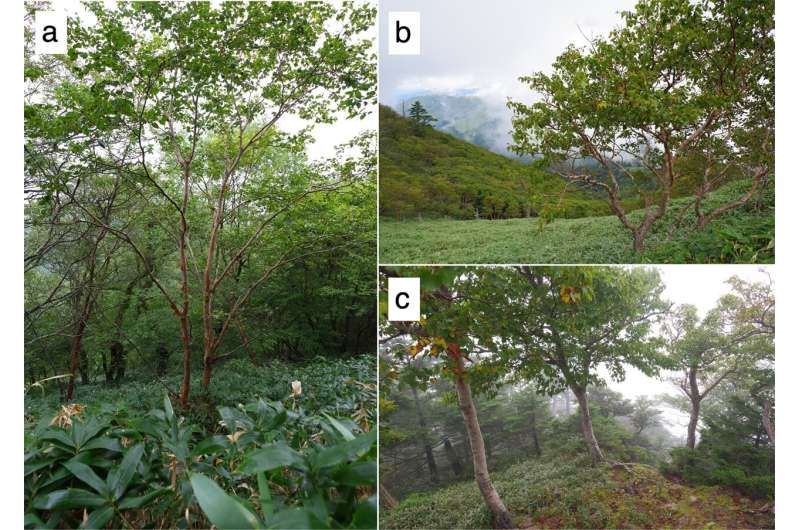This article has been reviewed according to Science X's editorial process and policies. Editors have highlighted the following attributes while ensuring the content's credibility:
fact-checked
peer-reviewed publication
trusted source
proofread
Discovery of ancestral diploid lineage of Betula ermanii in Japan's high mountains

Betula ermanii, a tree species native to the high mountains in Japan and the cold and snowy regions of Russia, is usually tetraploid (possessing four genome sets). However, the species found on Shikoku Island and Kii Peninsula are diploid with only two genome sets, suggesting an ancestral lineage.
This discovery, reported in PLOS One, could shed light on the species' history and its adaptation to harsh environments.
Most organisms are diploids, meaning that they have two genome sets. Genome polyploidy is a major driver of species diversification and speciation.
Polyploids are often cultivated as plant foods (e.g., wheat and persimmon) because they commonly form larger organs than diploids. In addition, wild plant polyploidy tends to be more abundant in arid and cold regions. Therefore, by following the process of polyploidy, we can possibly understand how species have adapted to harsh environments.
Betula ermanii, a tetraploid with four genome sets, is a deciduous tree widely distributed in the cold and snowy regions of the Japanese archipelago, Korean Peninsula, and Far Eastern Russia.
In Japan and East Asia, B. ermanii is an essential species of the vegetation-formation process in mountainous areas higher than 1500 m. Recent phylogenetic studies of the Betula genus have suggested that B. ermanii originated from a hybrid of two diploid species; also, unidentified diploids might exist in close lineages.
Previously, the research team revealed a wide genetic difference between the B. ermanii native to the Kii Peninsula, the southern boundary of the species' range, and other B. ermanii populations.
In this study, they comprehensively surveyed the southern boundary of the native populations and examined the leaf and seed morphologies and polyploidy of individuals from Mt. Ishizuchi and Mt. Tsurugisan on Shikoku Island, and from Mt. Shakagatake in the Kii Peninsula.
Individuals from these southernmost areas were identified as diploids; moreover, their leaf and seed morphologies differ from those of the tetraploid Honshu strain.
These areas are home to many endemic plant groups that likely migrated to the Japanese archipelago in ancient times. The diploid lineage of B. ermanii, is also considered as an ancestral lineage, might provide important clues to understand the history of this species, which has widely spread to high mountains and cold environments.
The diploid lineage might also reveal the process of vegetation formation in the mountainous regions of the Japanese Archipelago.
More information: Takaki Aihara et al, Cryptic diploid lineage of Betula ermanii at its southern boundary populations in Japan, PLOS ONE (2024). DOI: 10.1371/journal.pone.0307023
Journal information: PLoS ONE
Provided by University of Tsukuba



















